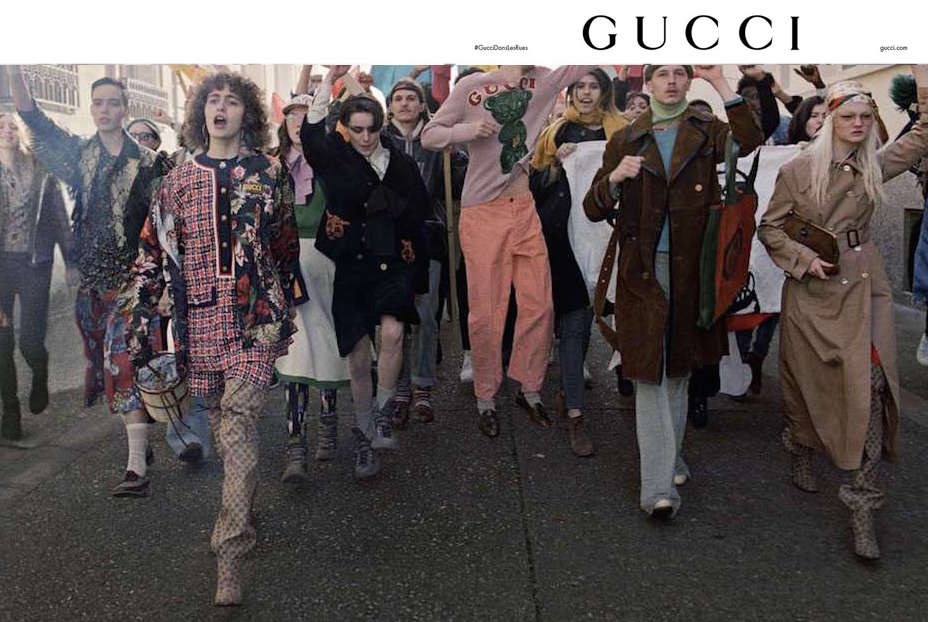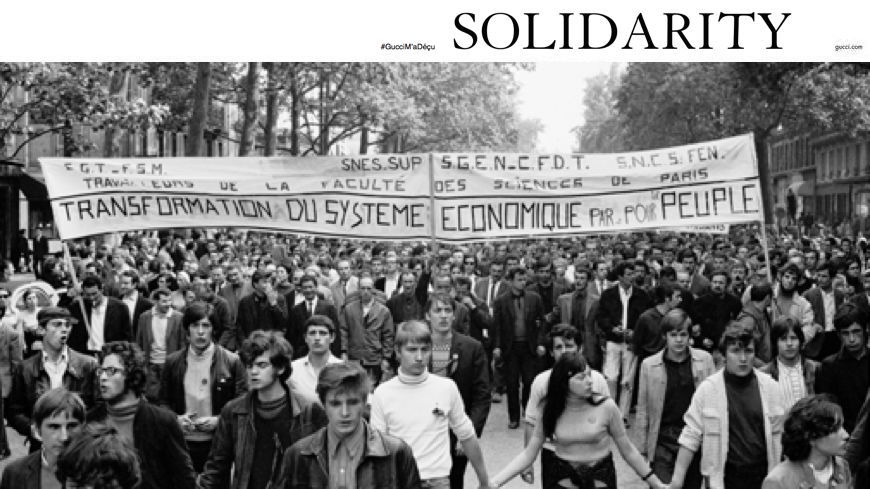
Gucci’s pre-fall campaign is supposed to transport us to the “May ‘68” uprising in Paris. It is unlikely that the target demographic is aware of the referenced event, though the ad does capture a general nostalgia for the energy and idealism of the 1960’s. Given the current political climate, the ad is likely to evoke more recent protests and so tension is created between the scene set and the ideas prompted.
The “protester” as icon, in this ad, is intended to signify youthful rebellion and irreverence. The “protest” is meant to be representative of enacting nonconformity. The May 1968 uprising is framed, in this case, as a movement championing freedom of expression. However, the icon of the “protestor” has a historical and present rooting in the common visual lexicon and so it becomes the signifier for more expansive conceptualization than intended. A viewer may read the “protester” as a dissident/troublemaker, a free-spirit, or as a socio-political actor in a specific movement.
By presenting their campaign as nostalgic, Gucci is able to capitalize on “liberal” leaning members of their demographic, while avoiding any direct connection that might alienate others. The ad feels vintage, but remains ahistorical (without investigating #GucciDansLesRues). A safety of nonspecificity surrounds the construction of the image. The demonstrators raise their fists, and a woman in the foreground chants, but there is nothing to root the imagery in any political context; it is protest for protest’s sake.
The campaign is grounded in the narrative of a student and artists’ rebellion. The youthfulness and eclectic garb, as well as the grainy, documentarist photography suggest this visually, while the website is more explicit. Yet, the tweed dress being marketed costs $3,200 (Gucci). There is dissonance between the character invoked and the reality of the bourgeois consumer, even as there is a disparity between the “protester” as icon, and a protester as one would understand the role within a political context, and there is an unnavigable gap between the social actors being conjured and the customer being targeted.
There are three archetypal presences vying for attention: the rebel of American ideal, whose individuality is key; the dissident, whose work relies on collective political action; and the elite consumer, whose survival requires the failure of socialism. This ad appropriates the power of demonstration and supplies expensively tailored individuality

I considered multiple directions when remaking the ad I selected. There was such a disparity between who Gucci was portraying and the consumers they were targeting. Originally, I thought that highlighting the ostentacion of the brand, in contrast to the image of the gritty street protest being staged would be interesting. Then, I considered using images of more recent protests, ones that are resonant with modern viewers. I thought about showing the adversity people face while protesting (arrest, police brutality, terrorist violence as in Charlottesville), or focusing on the messages of demonstrators. I wanted to show that movements are driven by deeply entrenched political ideals; that people are protesting because their basic rights to life and freedom of movement, their safety and families are being targeted and taken away. People are taking to the streets for heartbreaking and enraging reasons that shouldn’t be undermined or erased by turning the icon of “protester” into a branded lifestyle. However I couldn’t see a way forward without decontextualizing or co-opting the sources I wanted to spotlight.
Gucci’s campaign is to meant to celebrate Paris, of May ‘68 and that’s what I have chosen to do. I’ve replaced the Gucci brand-name with “solidarity,” in Gorjan (the Gucci font), in order to keep the imagery cohesive and reflective of the original. I am using an image from the May 1968 uprising: of a sea of protesters, hand in hand, carrying a banner which reads, “Transformation du système économique par et pour le peuple” (Seine, 1968). Transformation of the economic system by and for the people. This act of rebellion highlighted youth and individualism, but it was a collective undertaking, that would never have been possible without the solidarity of students, communists, activists and union workers. I have turned away from the Values and Lifestyles consumer model (There is a Policeman) and returned to the imagery that supposedly inspired the ad, to reinforce the true values sidelined by the Gucci narrative.
Gucci advertisement. Vogue, June 2018, p. 4-5.
Seine, Jean-Claude. Untitled. 1968. Alomomento.mx. Film. Accessed June 30.
“There is a Policeman Inside All of Our Heads, He Must Be Destroyed.” The Century of Self, segment 3, 17 Mar. 2002.